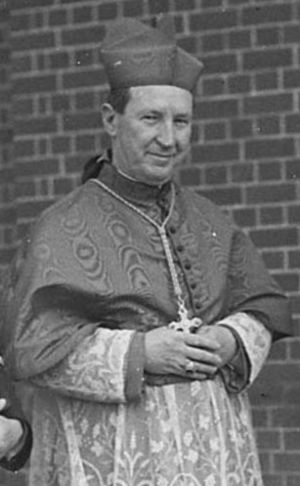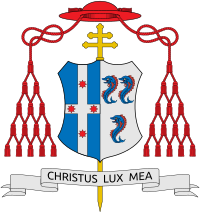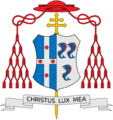Norman Gilroy facts for kids
Quick facts for kids Norman Gilroy |
|
|---|---|
| Cardinal Archbishop Emeritus of Sydney |
|

Gilroy in 1946
|
|
| Church | Roman Catholic Church |
| Archdiocese | Sydney |
| See | Sydney |
| Appointed | 8 March 1940 |
| Reign ended | 9 July 1971 |
| Predecessor | Michael Kelly |
| Successor | James Darcy Freeman |
| Other posts | Cardinal-Priest of Santi Quattro Coronati (1946-71) President of the Australian Episcopal Conference (1958-71) |
| Orders | |
| Ordination | 24 December 1923 |
| Consecration | 17 March 1935 by Filippo Bernardini |
| Created Cardinal | 18 February 1946 |
| Rank | Cardinal-Priest |
| Personal details | |
| Birth name | Norman Thomas Gilroy |
| Born | 22 January 1896 Glebe, Sydney, New South Wales, Australia |
| Died | 21 October 1977 (aged 81) Lewisham, Sydney, New South Wales, Australia |
| Nationality | Australian |
| Denomination | Catholic (Roman Rite) |
| Previous post | Bishop of Port Augusta (1934-37) Titular Archbishop of Cypsela (1937-40) Coadjutor Archbishop of Sydney (1937-40) |
| Education | Marist Brothers' College |
| Alma mater | Pontifical Urbaniana University |
| Motto | Christus lux mea |
| Coat of arms |  |
| Styles of Norman Gilroy |
|
|---|---|
 |
|
| Reference style | His Eminence |
| Spoken style | Your Eminence |
| Informal style | Cardinal |
| See | Sydney |
Sir Norman Thomas Gilroy (born January 22, 1896 – died October 21, 1977) was an important Australian bishop. He made history as the first Australian-born cardinal in the Roman Catholic Church.
Contents
Early Life and Becoming a Priest
Norman Gilroy was born in Sydney, Australia. His parents were working-class people from Ireland. He went to Marist Brothers' College in Kogarah, Sydney.
When he was 13, he left school to work as a messenger for the postal service. In 1914, his parents did not want him to join the army. But they let him volunteer for the transport service. He worked as a wireless operator.
In February 1915, he left Australia. He served in World War I during the Gallipoli campaign. He was a wireless operator on a ship.
After returning to Australia in August 1915, he went back to his job. He then decided he wanted to become a priest. He started his studies in 1917. From 1919, he continued his studies in Rome.
He became a priest on December 24, 1923, in Rome. The next year, he earned an advanced degree in religious studies.
In 1924, Gilroy returned to Australia. He worked at a Church office in Sydney. The head of this office, Archbishop Bartolomeo Cattaneo, wanted more Australian priests to become bishops. After six years, Gilroy moved to Lismore. There, he became an important helper to the Bishop.
Becoming a Bishop and Cardinal
In December 1934, Norman Gilroy was chosen to be the Bishop of Port Augusta in South Australia. This job helped him learn how to solve problems for his church members. He officially became a bishop on March 17, 1935.
In 1937, he became the Coadjutor Archbishop of Sydney. This meant he was a helper to the Archbishop of Sydney. When Archbishop Michael Kelly passed away, Gilroy took over. He became the Archbishop of Sydney on March 18, 1940.
On February 18, 1946, Gilroy was made a cardinal. He was given the title of cardinal-priest of Santi Quattro Coronati. This was a very special moment. He became the first cardinal born in Australia.
In 1953, he helped lay the first stone for a church in the Philippines. It was called the National Shrine of Our Mother of Perpetual Help.
Later Life and Achievements
In 1969, Cardinal Gilroy was given a special honor. He was knighted and became "Sir Norman Gilroy." He was the first Roman Catholic cardinal to receive a knighthood since the English Reformation. In 1970, he was named Australian of the Year.
He retired as Archbishop of Sydney in July 1971. He passed away in Sydney in 1977, at 81 years old. James Darcy Freeman took his place as Archbishop.
As Archbishop, Gilroy made sure his clergy (priests) followed strict rules. He was known for being very firm. But he also showed kindness to those who struggled.
He worked hard to build many churches and schools. By 1971, there were 366 Catholic schools with over 115,000 students. These schools were taught by many religious brothers, nuns, and other teachers. He also wanted to start a Catholic university. While that didn't happen, he did help create a theology faculty in Manly.
In the 1950s, there was a big disagreement within the Australian Labor Party. Gilroy believed the Church should not get too involved in politics. He was a supporter of the Labor Party. He did not agree with some political activities by other Church leaders. Because of his views, the Labor Party in New South Wales did not split.
In 2017, a book about Gilroy's life was published. It shared new information and gave a true picture of the man. He rose from a postal worker to a very high position in the Church.
Legacy
Gilroy College is a high school in north-western Sydney. It was named after Norman Gilroy and opened in 1980. The school uses Gilroy's personal motto, "Christ is my light," as its own. In 2004, Gilroy College celebrated its 25th anniversary.
Images for kids
See also
 In Spanish: Norman Thomas Gilroy para niños
In Spanish: Norman Thomas Gilroy para niños



